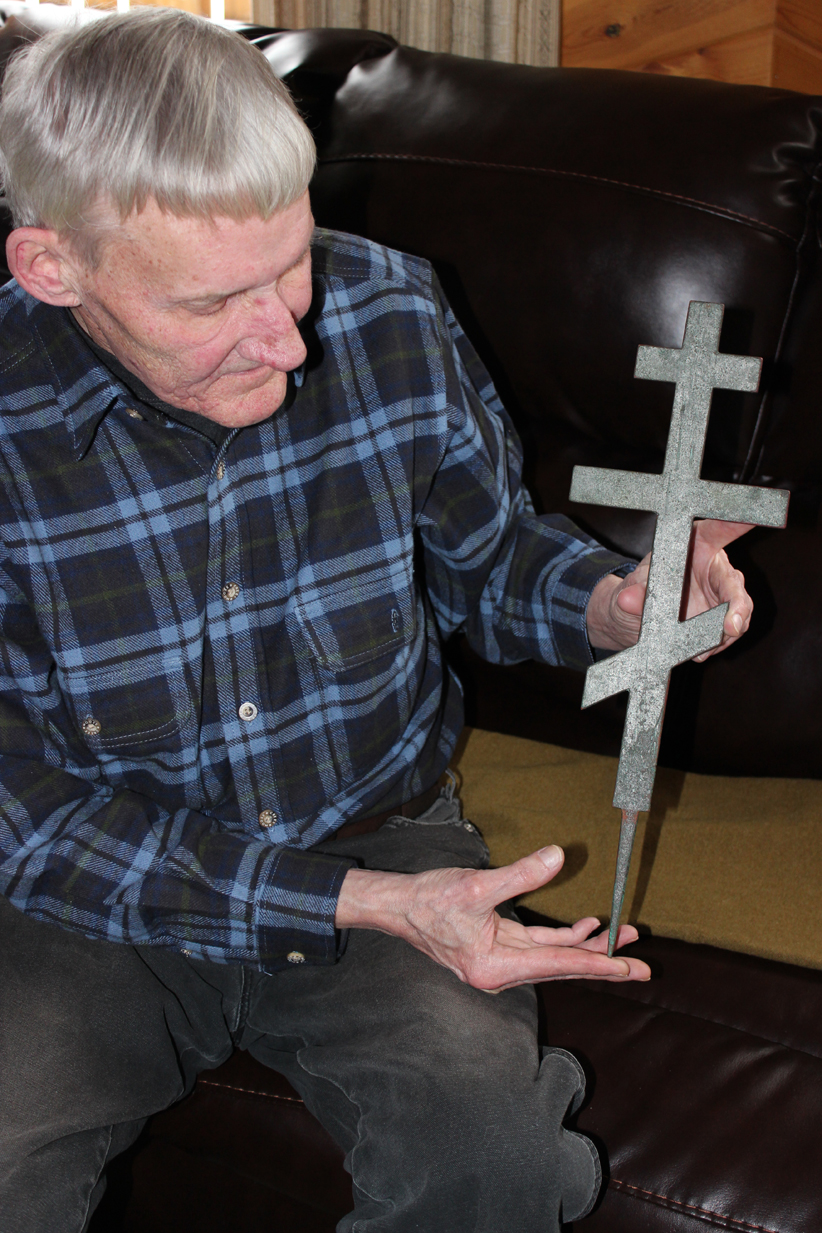It’s been almost a year since Peter Zollars came upon the metal cross along the beach of a Kachemak Bay island. Since then, he and local historian Janet Klein have been searching for information about its origin and purpose.
They have been able to find little information, making it clear there is more to be known.
“We don’t know its age or its origin,” said Zollars. “Of course, it raises the question why this piece is showing up in such a remote place. … The more we talk, the more I puzzle, the more we all puzzle over it.”
The cross measures eighteen inches in length, the longest crosspiece is six inches. It’s about one-eighth of an inch thick and weighs a little less than a pound. At the bottom of it is a spike about four and a quarter inches long.
“It almost looks as if there was some handtooling on portions of it. There’s a groove on the end and its not grooved on the other side, which may have facilitated planting it in the ground or wood,” said Zollars.
Klein, who wrote “Archaeology of Kachemak Bay, Alaska,” said the cross’s overall shape may prove a clue to its purpose.
“It clearly indicates to me it had a front and back,” said Klein. However, in all her research, she has found nothing resembling it in any photographs.
Last June the cross was found near the site of some ongoing archaeological work. Its surface is relatively smooth, not cobbled as it might have been had it been tossed around by the water.
“Based on that and the fact of how it was found has led us to the conclusion it may have been representative of a burial marker and subsequently knocked over by the forces of nature, covered and only recently dredged up and caught up in the driftwood and kelp,” said Zollars.
While the spike at the bottom of the cross indicates it was meant to stand upright, Zollars said the area where it was found has been eroding, which would cause the cross to fall over.
On a recent trip to Fairbanks, Klein showed the cross to anthropologist Katherine Arndt of the University of Alaska Fairbanks. Arndt confirmed that it was a burial cross. But for whom?
Klein shared a photo of the cross with Mina Jacobs, former curator of the Russian Orthodox Museum in Anchorage. Jacobs said she had never seen anything like it.
Originally from New Orleans, La., Zollars was pursuing a degree in biology and doing specialty work in herpetology when he chanced upon some exposed archaeological material.
“I suddenly went from biologist to archaeologist,” he said of the interest sparked by that find.
That interest finally led him to Alaska in the late 1970s, where he studied archaeology at the University of Alaska Anchorage. While doing work in Kachemak Bay, Zollars had the opportunity to meet Frederica de Laguna, the first archaeologist to examine the Kachemak Bay area.
In 1987, Zollars and Klein met. Their combined knowledge of history and the area is evident when they discuss possible origins of the cross.
“It may have belonged to a traveling priest, in a traveling kit to accommodate the needs of someone that passed away who practices Russian Orthodoxy. That’s hypothetical, of course. Whether that’s the case, we don’t know,” said Zollars.
Could it have been crafted in Russian America?
“There was quite a bit of shipbuilding going on then,” said Klein. “That was certainly a source of metal. It could have come from that.”
Perhaps the cross was picked up by someone aboard the Torrent, a ship that struck Bird Reef and sunk in 1868.
Several years ago, in the same area associated with where the cross was found, Klein found a very small gilded silver button. Her research has placed the button in the late 1800s and identified it as an adornment of vestments worn by Russian Orthodox bishops.
“As rare as these artifacts are, they compliment each other,” said Zollars, referring to the cross and the button.
That may be true. Or it may not.
“I think we have as much information as we can get,” said Zollars, eager to let the public know so “we can see if we can solicit any more information.”
Anyone with knowledge that can help unravel the mysteries of the cross can contact Zollars at 435-0440 or Klein at 235-8925.
McKibben Jackinsky can be reached at mckibben.Jackinsky@homernews.com.


